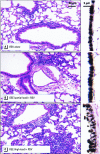Engine-operating load influences diesel exhaust composition and cardiopulmonary and immune responses
- PMID: 21524982
- PMCID: PMC3237353
- DOI: 10.1289/ehp.1003101
Engine-operating load influences diesel exhaust composition and cardiopulmonary and immune responses
Abstract
Background: The composition of diesel engine exhaust (DEE) varies by engine type and condition, fuel, engine operation, and exhaust after treatment such as particle traps. DEE has been shown to increase inflammation, susceptibility to infection, and cardiovascular responses in experimentally exposed rodents and humans. Engines used in these studies have been operated at idle, at different steady-state loads, or on variable-load cycles, but exposures are often reported only as the mass concentration of particulate matter (PM), and the effects of different engine loads and the resulting differences in DEE composition are unknown.
Objectives: We assessed the impacts of load-related differences in DEE composition on models of inflammation, susceptibility to infection, and cardiovascular toxicity.
Methods: We assessed inflammation and susceptibility to viral infection in C57BL/6 mice and cardiovascular toxicity in APOE-/- mice after being exposed to DEE generated from a single-cylinder diesel generator operated at partial or full load.
Results: At the same PM mass concentration, partial load resulted in higher proportions of particle organic carbon content and a smaller particle size than did high load. Vapor-phase hydrocarbon content was greater at partial load. Compared with high-load DEE, partial-load DEE caused greater responses in heart rate and T-wave morphology, in terms of both magnitude and rapidity of onset of effects, consistent with previous findings that systemic effects may be driven largely by the gas phase of the exposure atmospheres. However, high-load DEE caused more lung inflammation and greater susceptibility to viral infection than did partial load.
Conclusions: Differences in engine load, as well as other operating variables, are important determinants of the type and magnitude of responses to inhaled DEE. PM mass concentration alone is not a sufficient basis for comparing or combining results from studies using DEE generated under different conditions.
Conflict of interest statement
This article was prepared as an account of work sponsored by an agency of the U.S. government. Neither the U.S. government nor any agency thereof, nor any of their employees, makes any warranty, expressed or implied, or assumes any legal liability or responsibility for the accuracy, completeness, or usefulness of any information, apparatus, product, or process disclosed or represents that its use would not infringe on privately owned rights. Reference herein to any specific commercial product, process, service by trade name, trademark, manufacturer, or otherwise does not necessarily constitute or imply its endorsement, recommendation, or favoring by the U.S. government or any agency thereof. The views and opinions of the authors expressed herein do not necessarily state or reflect those of the U.S. government or any agency thereof. No copyright is asserted in the works of U.S. government employees.
The authors declare they have no actual or potential competing financial interests.
Figures





Comment in
-
All diesel exhaust is not the same: engine load alters toxicity.Environ Health Perspect. 2011 Aug;119(8):A355. doi: 10.1289/ehp.119-a355b. Environ Health Perspect. 2011. PMID: 21807581 Free PMC article. No abstract available.
References
-
- Boothe VL, Shendell DG.2008Potential health effects associated with residential proximity to freeways and primary roads: review of scientific literature, 1999–2006. J Environ Health 7033−41 - PubMed
-
- Campen MJ, Babu NS, Helms GA, Pett S, Wernly J, Mehran R, et al. Nonparticulate components of diesel exhaust promote constriction in coronary arteries from ApoE-/- mice. Toxicol Sci. 2005;88:95–102. - PubMed
-
- Campen MJ, McDonald JD, Gigliotti AP, Seilkop SK, Reed MD, Benson JM. Cardiovascular effects of inhaled diesel exhaust in spontaneously hypertensive rats. Cardiovasc Toxicol. 2003;3:353–361. - PubMed
Publication types
MeSH terms
Substances
Grants and funding
LinkOut - more resources
Full Text Sources
Other Literature Sources
Miscellaneous

